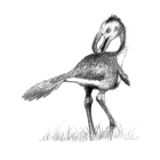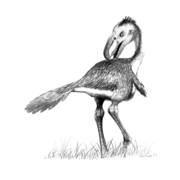
Andalgalornis
Encyclopedia
Andalgalornis was a genus
of flightless predatory bird
s of the family
Phorusrhacidae
(often called "terror birds") that lived in Argentina
. The type
and only species
is A. steulleti.
 Andalgalornis is known from an incomplete skeleton and some single bones found from sites in the Entre Ríos
Andalgalornis is known from an incomplete skeleton and some single bones found from sites in the Entre Ríos
and Catamarca Province
s of northeast and northwest Argentina. The fossils were uncovered from the Miocene
to Early Pliocene
Andalgala Formation.
Andalgalornis stood around one and a half meters tall. The subfamily to which the genus belonged, the Patagornithinae, contained species that were of quite slender build; it looked much like the larger phorusrhacid Phorusrhacos
, but it was more elegant and smaller and had a proportionally higher beak, the most massive in proportion to body size of all phorusrhacids. A recent analysis of CT scans of the skull of Andalgalornis suggests that the beak was strong dorsoventrally (in the vertical plane) but relatively weak mediolaterally on either side. The beak's weakness suggests that the bird could not have taken down large prey, but consumed smaller, more easily manageable and less risky prey. However, the beak's dorsoventral strength may have enabled Andalgalornis to quickly strike down on its prey in a repeated attack-and-retreat hunting strategy.
Genus
In biology, a genus is a low-level taxonomic rank used in the biological classification of living and fossil organisms, which is an example of definition by genus and differentia...
of flightless predatory bird
Bird
Birds are feathered, winged, bipedal, endothermic , egg-laying, vertebrate animals. Around 10,000 living species and 188 families makes them the most speciose class of tetrapod vertebrates. They inhabit ecosystems across the globe, from the Arctic to the Antarctic. Extant birds range in size from...
s of the family
Family (biology)
In biological classification, family is* a taxonomic rank. Other well-known ranks are life, domain, kingdom, phylum, class, order, genus, and species, with family fitting between order and genus. As for the other well-known ranks, there is the option of an immediately lower rank, indicated by the...
Phorusrhacidae
Phorusrhacidae
Phorusrhacids , colloquially known as "terror birds" as the larger species were apex predators during the Miocene, were a clade of large carnivorous flightless birds that were the dominant predators in South America during the Cenozoic, 62–2 million years ago. They were roughly 1–3 meters tall...
(often called "terror birds") that lived in Argentina
Argentina
Argentina , officially the Argentine Republic , is the second largest country in South America by land area, after Brazil. It is constituted as a federation of 23 provinces and an autonomous city, Buenos Aires...
. The type
Type species
In biological nomenclature, a type species is both a concept and a practical system which is used in the classification and nomenclature of animals and plants. The value of a "type species" lies in the fact that it makes clear what is meant by a particular genus name. A type species is the species...
and only species
Species
In biology, a species is one of the basic units of biological classification and a taxonomic rank. A species is often defined as a group of organisms capable of interbreeding and producing fertile offspring. While in many cases this definition is adequate, more precise or differing measures are...
is A. steulleti.

Entre Ríos Province
Entre Ríos is a northeastern province of Argentina, located in the Mesopotamia region. It borders the provinces of Buenos Aires , Corrientes and Santa Fe , and Uruguay in the east....
and Catamarca Province
Catamarca Province
Catamarca is a province of Argentina, located in the northwest of the country. The province has a population of 334,568 as per the , and covers an area of 102,602 km². Its literacy rate is 95.5%. Neighbouring provinces are : Salta, Tucumán, Santiago del Estero, Córdoba, and La Rioja...
s of northeast and northwest Argentina. The fossils were uncovered from the Miocene
Miocene
The Miocene is a geological epoch of the Neogene Period and extends from about . The Miocene was named by Sir Charles Lyell. Its name comes from the Greek words and and means "less recent" because it has 18% fewer modern sea invertebrates than the Pliocene. The Miocene follows the Oligocene...
to Early Pliocene
Pliocene
The Pliocene Epoch is the period in the geologic timescale that extends from 5.332 million to 2.588 million years before present. It is the second and youngest epoch of the Neogene Period in the Cenozoic Era. The Pliocene follows the Miocene Epoch and is followed by the Pleistocene Epoch...
Andalgala Formation.
Andalgalornis stood around one and a half meters tall. The subfamily to which the genus belonged, the Patagornithinae, contained species that were of quite slender build; it looked much like the larger phorusrhacid Phorusrhacos
Phorusrhacos
Phorusrhacos was a genus of giant flightless predatory birds that lived in Patagonia, containing the single species Phorusrhacos longissimus. Their closest living relatives are the much smaller seriema birds...
, but it was more elegant and smaller and had a proportionally higher beak, the most massive in proportion to body size of all phorusrhacids. A recent analysis of CT scans of the skull of Andalgalornis suggests that the beak was strong dorsoventrally (in the vertical plane) but relatively weak mediolaterally on either side. The beak's weakness suggests that the bird could not have taken down large prey, but consumed smaller, more easily manageable and less risky prey. However, the beak's dorsoventral strength may have enabled Andalgalornis to quickly strike down on its prey in a repeated attack-and-retreat hunting strategy.

